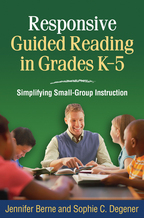Responsive Guided Reading in Grades K-5
Simplifying Small-Group Instruction
Jennifer Berne and Sophie C. Degener
Paperbacke-bookprint + e-book
Paperback
orderApril 23, 2010
ISBN 9781606237038
Price: $31.00162 Pages
Size: 6" x 9"
Guided reading is a staple of elementary literacy instruction, yet planning and conducting reading groups can be time consuming and challenging. This hands-on book presents an innovative approach to guided reading that is manageable even for teachers who are new to small-group, differentiated reading instruction. Numerous classroom examples illustrate how to organize groups and select suitably challenging materials, structure group sessions, provide scaffolding and cues while listening to students read, and balance small-group with whole-class instruction. Special features include scheduling aids and lists of common cues for beginning and older readers, as well as suggestions for further reading at the end of each chapter.
“This book will help new teachers and those new to guided reading 'get their feet wet' with this type of instruction. The authors provide teacher-friendly guidelines for assisting all students—beginning readers to able decoders—using methods that are easily integrated into the classroom. Teachers will welcome the useful instructional tools in this book.”
—Sandra K. Athans, MA, fourth-grade teacher, Chittenango Central School District, New York
“This book makes conducting daily reading groups manageable in today's hectic classrooms. It helps teachers prioritize the most important aspect of this type of instruction: giving each child individualized attention and feedback. Every aspect of responsive guided reading is covered, including step-by-step directions and cues. As a reading specialist, I got a wealth of information to share with struggling teachers who need to simplify their reading groups in order to be successful. The book is also an excellent choice for a faculty book study for teachers making the transition to differentiated instruction in RTI.”
—Anita Beasley, EdS, reading specialist, Butts County Public Schools, Georgia
“Berne and Degener address the critical question facing preservice and beginning teachers: 'How do I teach reading?' The book provides a complete understanding of responsive guided reading, including step-by-step explanations for implementation, strategies for coordinating instructional decision making with assessment, and ways to integrate the approach into a sustainable classroom context. The suggested readings at the end of each chapter enhance the book's value as a learning tool for both new and experienced teachers seeking to refine their literacy repertoires.”
—Kathy Headley, EdD, Professor and Associate Dean for Research and Graduate Studies, College of Health, Education, and Human Development, Clemson University
“Berne and Degener stand on the shoulders of literacy leaders such as Fountas and Pinnell, Allington, and Clay, but have further refined guided reading. This book will be especially helpful for teachers trying to get classrooms and students organized for guided reading while providing meaningful differentiated literacy activities for the remainder of the class. It will benefit not only new teachers organizing their classrooms for the first time, but also experienced teachers who want to ramp up their current centers and guided reading practices.”
—Terri Lowery, MA, first-grade teacher and primary literacy coordinator, Union Elementary School, Warsaw, Ohio
Table of Contents
I. What Is Responsive Guided Reading?1. Introduction
2. The Role of Responsive Guided Reading in the Balanced Literacy Block
3. A Detailed Look at Responsive Guided Reading
II. Teacher Cueing in Responsive Guided Reading Groups
4. Prompting Beginning Readers during Responsive Guided Reading
5. Prompting Fluent Readers during Responsive Guided Reading
III. Getting Started with Responsive Guided Reading: Practical Considerations
6. The First Month of School: Establishing Routines
7. Meaningful Activities for the Rest of the Class
8. Assessing Students for Placement in Responsive Guided Reading Groups
9. Moving Students in and out of Groups
10. Selecting Materials for Responsive Guided Reading Groups
About the Authors
Jennifer Berne, PhD, is Associate Professor at National-Louis University, where she is also chair of the Department of Reading and Language Arts. She teaches courses in comprehension, the teaching of writing, and literacy methods. Dr. Berne’s publications include work on teacher professional development, the teaching of process writing, and comprehension strategy instruction. She spent 10 years in adult literacy, teaching underprepared college students the strategies needed for reading and writing in higher education. This classroom experience has anchored her interest in contemporary literacy practices and informs her work in pre- and inservice teacher learning. In addition to her work teaching, researching, and writing, Dr. Berne acts as a literacy consultant and professional developer in urban, rural, and suburban school districts working to refresh their literacy curriculum.Sophie C. Degener, EdD, is Assistant Professor in the Department of Reading and Language Arts at National-Louis University, where she teaches classes in beginning reading, reading research, and literacy methods to undergraduates, master’s students, and doctoral students. Her research interests include family literacy and primary literacy instruction, and her numerous conference presentations and publications reflect those interests. Prior to her work as a professor, Dr. Degener taught in the primary grades. It is her work with struggling readers and their families that has motivated her interest in helping educators at every grade level to understand the unique needs of each and every student and to design differentiated instruction that best meets those needs.
